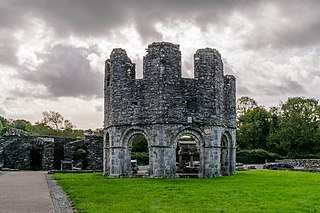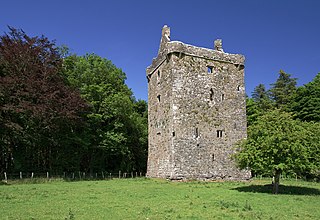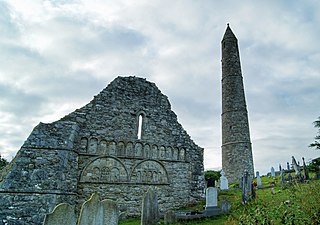
Ballinamore is a small town in the south-east of County Leitrim in Ireland.

The Synod of Ráth Breasail was a synod of the Catholic Church in Ireland that took place in Ireland in 1111. It marked the transition of the Irish church from a monastic to a diocesan and parish-based church. Many present-day Irish dioceses trace their boundaries to decisions made at the synod.
Aedh mac Ruaidrí Ua Conchobair was King of Connacht from 1228 to 1233. He was one of the sons of the last fully recognized High King of Ireland Ruaidrí Ua Conchobair, and claimed the kingship of Connacht after deposing his brother Toirdhealbhach Ó Conchobhair, after the death of their rival, cousin and former king Aedh Ua Conchobair. In 1233 he was killed in battle by the supporters of his cousin and successor Felim O'Connor. He was the last descendant of Ruaidrí to hold the kingship.
Felim McHugh O'Connor was king of Connacht in Ireland from January 1310 to 10 August 1316. The beginning of his kingship saw a revival in the ancient form of inauguration performed for the Kings of Connacht after a period of apparent lapse in the practice. His reign took place against the background of a Gaelic recovery following the Anglo-Norman invasion and the disputed High Kingship of Edwurd Bruce. He was the last King of Connacht to truly hold power over the entire province and his death halted the gains that had been made following the Anglo Norman invasion, by his kingdom. His foster father Maelruanid Mac Diarmata King of Magh Lurg would play an instrumental role in his reign.

Felim O'Connor was king of Connacht in Ireland, having been proclaimed king by Richard Mór de Burgh in 1230, he reigned proper from 1233 until 1265. Felim died in that year and was buried in the Dominican Priory in Roscommon which he founded in 1253. On his accession Felim inherited many problems from his predecessors, having his territory limited to essentially County Roscommon and having to deal with an increase of English and Welsh settlers in the kingdom. Felim attempted to maintain both a loyal and personal relationship with Henry III King of England, hoping he would limit the influence of de Burgh and other powerful Anglo-Norman magnates in Connacht, but this policy of appeasement produced few concrete results. During Felim's reign the lands of the Ua Conchobair became limited to the five 'royal cantreds', essentially County Roscommon. Felim notably adopted aspects of Anglo-Norman culture as seen in his English style effigy and seal.
Áed mac Felidlimid Ó Conchobair, known as Áed na nGall, was king of Connacht alongside his father Felim from 1258 reigning solely from 1265 until his own death in 1274. He is credited with turning the tide on Norman expansion in Connacht at the Battle of Áth an Chip. Aed took a different approach than his father to dealing with English crown authority in Ireland, placing his faith in alliances with the Gaelic speaking world and becoming the chief supporter of Brian Ua Neill's bid to revive the high kingship of Ireland. His byname na nGall comes from his marriage in 1259 to a daughter of Dubhghall mac Ruaidri King of the Hebrides which brought him 160 gallowglass commanded by Dubhghall's younger brother Ailéan as a dowry.

Iarlaithe mac Loga, also known as Jarlath, was an Irish priest and scholar from Connacht, remembered as the founder of the monastic School of Tuam and of the Archdiocese of Tuam, of which he is the patron saint. No medieval biography of Jarlath is extant, but sources for his life and cult include genealogies, martyrologies, the Irish Lives of St Brendan of Clonfert, and a biography compiled by John Colgan in the 17th century.

The Synod of Kells took place in 1152, under the presidency of Giovanni Cardinal Paparoni, and continued the process begun at the Synod of Ráth Breasail (1111) of reforming the Irish church. The sessions were divided between the abbeys of Kells and Mellifont, and in later times the synod has been called the Synod of Kells-Mellifont and the Synod of Mellifont-Kells.
Áed Ua hOissín was consecrated first Archbishop of Tuam in 1152 and died in 1161. He was closely associated with Connacht royalty, and had served as abbot of Tuam.

Uí Díarmata was a local kingdom located in what is now north County Galway.
Muireadhach Ua Dubhthaigh was an Archbishop of Connacht, in Ireland.
Domhnall Ua Dubhthaigh, Archbishop of Connacht, died 1136.
Tadg Óg Ó hUiginn was an Irish poet.
Gilla Críst Ua Mocháin was an Irish craftsman, fl. 1120s.

Feartagar Castle, also called Jennings Castle, is a tower house and National Monument located in County Galway, Ireland.

Drumacoo is a medieval ecclesiastical site and National Monument located in County Galway, Ireland.
The Conmhaícne Dúna Móir, or Cenéoil Dubáin, were an early people of Ireland. Their tuath comprised at least the barony of Dunmore, in County Galway.

Dísert Óengusa is a medieval hermitage and National Monument located in County Limerick, Ireland.

St. Declan's Monastery, containing the remains of Ardmore Cathedral, is a former monastery and National Monument located in County Waterford, Ireland.

Killashee Round Tower is an Irish round tower that forms part of the monastic remnants of Killashee, County Kildare, Ireland. On the Record of Monuments and Places its number is KD024-003.














